|
|
 |
The STRUCTURES range of Hi-Tech Education equipment enables clear and comprehensive learning of structural STATICS covering a variety of theories and topics within Architectural, Mechanical, Civil and Structural Engineering.
These include FORCE, BENDING, SHEAR, ELASTICITY, BEAMS, ARCHED BRIDGES, SUSPENSION BRIDGES, TRUSSES, FRAMEWORKS and PORTALS. The STRUCTURES hardware can be connected to the Hi-Tech Education HDA200 Interface creating a stand alone solution within the laboratory. Alternatively the STRUCTURES hardware can be fully Data Acquisitioned in conjunction with the experiment software. With the software the students can benefit from a wider learning experience.
|
HST1 Universal Frame and
Stand Floor mounted frame for use with nearly all Hi-Tech STRUCTURES hardware. The frame has an internal working area of 1.22 x 0.76metres. The frame facilitates quick and easy attachment of all experiments and is backward compatible with earlier versions of Hi-Tech experiments. A full set of assembly instructions and tools are supplied. |
 |
|
HST100 Bench Mounted Frame The HST100 Bench Mounted Frame extends the variety available to our customers when mounting a Hi-Tech STRUCTURES Experiment. If space is limited to bench tops only this frame is ideal within the laboratory. It offers the same working area as the HST1 Universal Frame and Stand. |
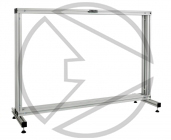 |
|
HDA200 Interface This unique and compact unit is essential for all Hi-Tech STRUCTURES experiments that come fitted with data output, requiring the parameters of Force, Strain, Deflection and Angle to be monitored and used with Experimental software. |
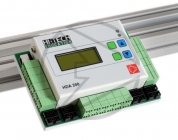 |
HST2 Simple Suspension BridgeA visually realistic Suspension Bridge with rigid deck, vertical tie rods and suspension cable allowing students to compare theoretical and experimental cable tensions and to study the performance of the bridge under varying load conditions. |
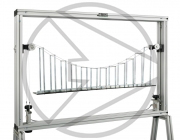 |
HST3 Plastic Bending of BeamDemonstration of the theory of plastic bending of a beam section and increase in bending moment due to redundancy. Students study the plastic collapse of a simply supported beam; a propped cantilever and a fixed beam, along with the collapse load for the beam. |
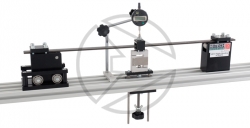 |
HST4 Three Hinged ArchA model Three Hinged Arch to investigate the horizontal thrust of its springing and calculation of its influence line. Symmetrical and unsymmetrical bridge sections are supplied to vary the experimental range of this experiment. Uniformly distributed loads and tandem rolling loads are supplied. |
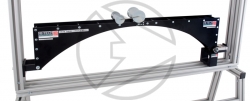 |
HST5 Two Hinged Parabolic ArchA Parabolic Two hinged Arch is used to compare horizontal reaction forces with simplified theory and to enable students to study and create influence lines. |
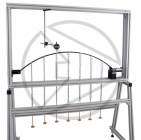 |
HST6 Parabolic Arch With Fixed EndsA visual experiment that allows students to evaluate the influence lines of horizontal thrust and end fixing moments (solution of three redundancies) of a parabolic arch with fixed ends, by direct measurement and advanced model analysis. |
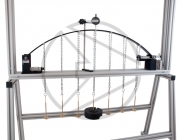 |
HST7 Deflection of FrameThis experiment takes students through the process of determining deflections by the unit load method, and then using the deflections of a portal frame to analyse a two-pinned portal. Through horizontal and vertical loading, the deflections of simply supported frames can be compared against theory using Castigliano’s theorem and Simpson’s rule. |
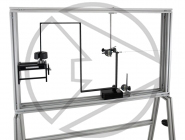 |
HST8 Plastic Bending of PortalsStudents study the collapse mechanism of two portal frames when subjected to simultaneous horizontal and vertical loading. They can then calculate and verify the position of greatest bending moment where plastic hinging is likely to form. |
 |
HST9 Shear Force in a BeamThis visually realistic experiment teaches students about the action of shear at a “cut” section in a beam and allows comparison of the measured values with theory. The apparatus emphasises both negative and positive shear. |
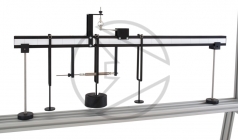 |
HST10 Bending Moment in a BeamStudents observe the action of bending moment at a “cut” section in a beam and compare the measured and theoretical values. The beam is in two halves and joined at the “cut” using a “hinge” mechanism. |
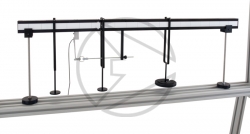 |
HST11 Continuous and Indeterminate BeamsEnables a wide range of beam experiments to measure support reactions, deflections and rotations of simply supported, fixed, indeterminate, two span continuous beams and propped cantilevers. Sinking supports can also be studied. |
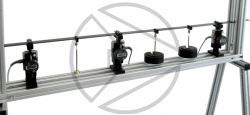 |
HST12 Deflection of Curved BarsStudents can compare the deflections of one end of a curved bar, with theoretical deflections derived from Castigliano’s theorem, mathematical integration or Simpson’s rule. Six cantilever test basrs are supplied. |
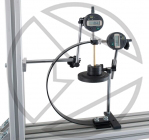 |
HST13 Deflections of Beams and CantileversAllows students to analyse the deflections experienced by beams and cantilevers under load and to verify the differential equation of a beam in the calculation of slopes and deflections. |
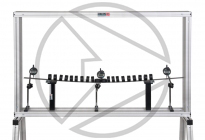 |
HST16 Redundant TrussA two bay, cantilevered truss enabling the measurement of strain (hence forces) and deflection in the individual members when a redundant member is force fitted into the arrangement. Enables comparison of experimental strains with theoretical values. |
 |
HST17 Forces in a Truss (Resolution)Students measure the axial strain and hence force in this realistic cantilevered truss with true pin joints. Allows comparison of experimental results with the member forces calculated by resolution at a joint. |
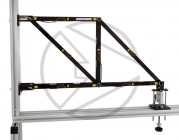 |
HST18 Suspended Centre Span BridgeThis experiment models a suspended centre span bridge. Students analyse the reaction influence lines for the bridge as a tandem rolling load (vehicle simulation) crosses it. |
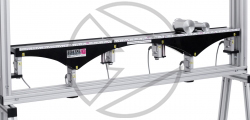 |
HST19 Pin Jointed FrameworksApparatus enabling students to assemble a variety of pin-jointed frameworks using struts and ties to measure the strains (hence stresses) and joint deflections. Two frameworks can be assembled with the components supplied. easily interconnected. The assembled frameworks mount onto two end pillars. |
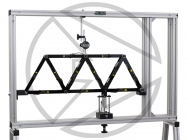 |
HST20 Bending Stress in a BeamExperiment for determining the bending stresses and strains within a T-beam. Students learn about strain gauging, bending equation, neutral axis and second moment of area, using an inverted T-beam. |
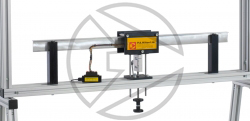 |
HST21 Unsymmetrical Bending & Shear Centre ApparatusApparatus allowing the relationship between vertical and horizontal deflections and the principle moments of area for a number of different sectioned specimens. The shear centre for the 'U' specimen can also be found. |
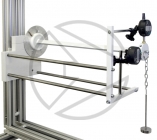 |
HST22 Torsion of Rods and TubesStudents verify the torsion equation with this apparatus by applying known torque to specimens of varying diameters, and materials. The theory also extends to non-circular specimens. |
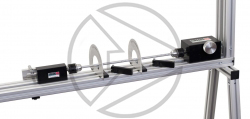 |
HST23 Equilibrium of ForcesA purely analogue experiment for the study of the equilibrium of forces acting in a single vertical plane. Students can study concurrent and non-concurrent forces in the vertical plane and also construct a polygon of forces. |
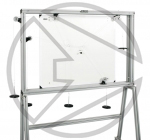 |
HST24 Equilibrium of Parallel ForcesExcellent for studying the equilibrium of vertical forces and the special case of equal and opposite parallel forces in a single plane. |
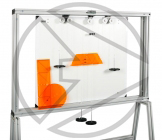 |
HST26 Deflections of BeamsApparatus to allow the study of beam deflections, the variables that control the deflection of a beam due to applied loads, the effect of changing the length and thickness of beams and studies the principle of superposition. |
 |
HST45 Buckling of StrutsThis apparatus mounts inside the HST1 Universal Frame and Stand (sold separately) and allows the study of the collapse (buckling) loads of metal specimens of varying length and compares this with Euler's theory and equations. |
 |